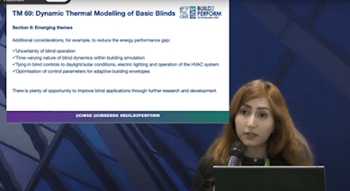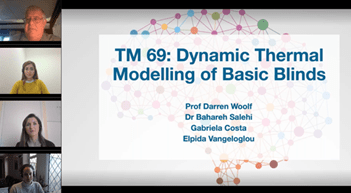In October 2022, CIBSE published a new Technical Memorandum on the Dynamic thermal modelling of basic blinds (TM69). The initiative of this publication came from the CIBSE Building Simulation Group, and several individuals, companies and organisations were involved in reaching this milestone.
The main authors of this publication are Prof Darren Woolf from Wirth Research, Dr Bahareh Salehi from Mott MacDonald, Maria Gabriela da Silva Costa from Useful Simple Trust, and Elpida Vangeloglou from Etheras Ltd. An interview with the authors was conducted by CIBSE to find out more about this publication and get a glimpse into what it was like being a CIBSE TM author, which can be found here: An interview with the authors of TM69.

Initially, this guideline was briefly presented at the Build2Perform 2022 event as part of the CIBSE Building Simulation Awards 2022.

TM69 was then unveiled in more detail at #GrowYourKnowledge webinar on the 21st of February 2023 which hosted more than 500 attendees from all around the world, including the UK, Ireland, Hong Kong, Australia, India, UAE, Italy, Belgium, Canada, Brazil, USA, Spain and many other countries. Link to the recording is: Registration (gotowebinar.com).

During the webinar, the main TM69 publication topics included were:
- Heat transfer through glazing and thermal comfort.
- Heat transfer through glass-blind system.
- Glass-blind performance where a case study was modelled to analyse the effect of internal simple blinds (considering parameters such as surface colour and air gaps) on air temperature, mean radiant temperature and operative temperature when assessing overheating risks and heat load calculations.
- Live application to show how to model a simple blind using a dynamic thermal modelling software tool whereby the workflow of blind modelling was discussed.
- Best usage in terms of applying blind models within regulatory, performance and/or compliance assessments, visual comfort, thermal comfort, natural ventilation, energy, heating and cooling loads, façade design, acoustic and operability of blinds.
- Emerging themes including complex blinds and possible uncertainties when modelling blinds.
There were also several interesting questions and points of discussion raised between the attendees and the authors during the webinar which have been highlighted below:
In Germany there is a requirement to calculate cooling load with blinds closed. What is your idea and vision of how to properly calculate cooling load calculation?
This is the best method for calculating cooling load in a building as blinds must be considered as the main part of the building. In this publication, the term “glass-blind system” is used which refers to the fact that window and shading devices should be considered as one piece. So, in the ideal situation, blinds must be closed (preferably with automated control) at some specific time of the day depending on the solar irradiance and internal temperature.
Are engineers likely to be comfortable with modelling cooling loads with blinds down?
This would not represent a worst-case scenario in terms of peak gains, and they would not want to receive complaints about overheating in the event that blinds are not lowered on a particularly hot day and the system/emitter doesn't have sufficient cooling capacity to achieve the set point.
Is there a recommended software?
Within the publication, various software tools are compared, and it is up to the user to choose the most suitable software tool for a particular project.
Are there any recommendations of specific thresholds for internal/external temperature and external solar incidence for raising/lowering blinds?
On the topic of thresholds to lower/raise blinds, it is difficult to recommend one standard approach applicable to all scenarios, given that blinds could be controlled manually (user behaviour would dictate how they are controlled) or automatically (a more defined approach can be followed). In the guide, we provide ranges within Table 3. Good practice would be to carry out model optimisation and discuss with the blind manufacturer, prior to explaining the impact of control thresholds to the design team and incorporating them into the Operation and Maintenance Manual. In a future advanced blind publication, it would be good to incorporate an evidence base on strategic control applications as well, for which supporting data would be needed.
Is there a test standard method for the thermal properties of the blind material, e.g. the conductivity, LW emissivity and LW transmittance?
For detailed input on test methods for product performance, it is good practice to contact the manufacturer. We would also recommend referring to the below documents, alternatively contact ES-SO or BBSA for more information.
- BS EN 14500:2021 Blinds and shutters, Thermal and visual comfort. Test and calculation methods (London: British Standards Institution)
- BS EN 14501:2021 Blinds and shutters. Thermal and visual comfort. Performance characteristics and classification (London: British Standards Institution)
The recent Part O Regulations is fairly strict in that it states blinds should not be used in the modelling to reach compliance, do you think this will change with this update? Could you please provide an explanation that this document (TM69) supports overheating analysis as blinds cannot be used to comply with Part O?
As long as a sensible approach is applied to façade performance and glazing ratio so that solar gains are managed at the first stage of the cooling hierarchy, then the internal blind can be complementary to that. This guide aims to support the modellers to better represent the use of internal blinds beyond compliance only. As the industry upskill in modelling dynamic building performance, building regulations might take a different approach in the future, but we are not in a position to comment on that.
What’s the current guidance on blinds from a Part L perspective? Previously we haven't modelled blinds for Part L as it is a risk to commit to it.
Internal blinds are not frequently used in compliance modelling, but they are accepted as a solution to control solar gains for Criterion 3. The need to close the performance gap does incentivise operational energy assessments as standard practice and it is therefore hoped that the value of blinds in reducing energy use intensities and peak loads will encourage design teams and developers to commit to blinds as part of their base build design.
How do you assess the impact of wind blowing through gaps in poorly draught-sealed openable windows?
In most dynamic thermal modelling exercises an assumption is made on the air permeability of the building considering its age, location, height and services, typically using the CIBSE Guide A tables. A more refined level of modelling would be to assign crack flow coefficients to the openings, considering the opening characteristics and pressure differentials. However, if a detailed analysis of the air flows through such gaps is required to answer specific questions on the building’s performance, then advanced modelling using computational fluid dynamics (CFD) would be appropriate.
What was the reason for not using ISO 52022-3:2017 instead of ISO 52022-1-2017?
The former Standard would be more aligned with a future advanced blinds publication. That said, it is still applicable for the basic blinds and would result in a more accurate calculation of gtot compared to the more simplified method adopted using the latter Standard.
We would like to express our sincere gratitude to all involved in this publication, we look forward to the next chapter of this publication, which will be focused on advanced blinds.
If you have any experience or case studies related to the use of advanced blinds, please get in touch with the team of authors at [email protected]
